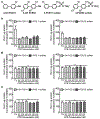Comparative Analyses of the 12 Most Abundant PCB Congeners Detected in Human Maternal Serum for Activity at the Thyroid Hormone Receptor and Ryanodine Receptor
- PMID: 30821444
- PMCID: PMC6457253
- DOI: 10.1021/acs.est.9b00535
Comparative Analyses of the 12 Most Abundant PCB Congeners Detected in Human Maternal Serum for Activity at the Thyroid Hormone Receptor and Ryanodine Receptor
Abstract
Polychlorinated biphenyls (PCBs) pose significant risk to the developing human brain; however, mechanisms of PCB developmental neurotoxicity (DNT) remain controversial. Two widely posited mechanisms are tested here using PCBs identified in pregnant women in the MARBLES cohort who are at increased risk for having a child with a neurodevelopmental disorder (NDD). As determined by gas chromatography-triple quadruple mass spectrometry, the mean PCB level in maternal serum was 2.22 ng/mL. The 12 most abundant PCBs were tested singly and as a mixture mimicking the congener profile in maternal serum for activity at the thyroid hormone receptor (THR) and ryanodine receptor (RyR). Neither the mixture nor the individual congeners (2 fM to 2 μM) exhibited agonistic or antagonistic activity in a THR reporter cell line. However, as determined by equilibrium binding of [3H]ryanodine to RyR1-enriched microsomes, the mixture and the individual congeners (50 nM to 50 μM) increased RyR activity by 2.4-19.2-fold. 4-Hydroxy (OH) and 4-sulfate metabolites of PCBs 11 and 52 had no TH activity; but 4-OH PCB 52 had higher potency than the parent congener toward RyR. These data support evidence implicating RyRs as targets in environmentally triggered NDDs and suggest that PCB effects on the THR are not a predominant mechanism driving PCB DNT. These findings provide scientific rationale regarding a point of departure for quantitative risk assessment of PCB DNT, and identify in vitro assays for screening other environmental pollutants for DNT potential.
Figures






References
-
- Hopf NB; Ruder AM; Succop P, Background levels of polychlorinated biphenyls in the U.S. population. Sci Total Environ 2009, 407, (24), 6109–19. - PubMed
-
- Berghuis SA; Bos AF; Sauer PJ; Roze E, Developmental neurotoxicity of persistent organic pollutants: an update on childhood outcome. Arch Toxicol 2015, 89, (5), 687–709. - PubMed
Publication types
MeSH terms
Substances
Grants and funding
LinkOut - more resources
Full Text Sources
Research Materials

